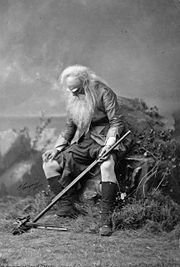The Mayas counted days vigesimally: "The unit of the Maya calendar was the day or kin. The second order of units, consisting of 20 kins, was called the uinal. In a perfect vigesimal system of numeration, the third term should be 400, that is, 20 * 20 * 1, but at this point, in counting time only, the Maya introduced a single variation, in order to make the period of their third order agree in length with with their calendar year as nearly as possible. The third order of the Maya vigesimal system, the tun, therefore, was composed of 18 (instead of 20) unials, or 360 (instead of 400) kins; 360 days or kins being a much close approximation to the length of the 365-day calendar year than 400 days. Above the third order, however, the unit of progression used to form all the higher numbers is uniformly 20, as will be seen below, where the names and numerical values of the nine know different orders of time periods are given:
╣ The period of the fifth order, the baktun, was originally called the 'cycle' by modern investigators. The ancient name for this period, however, was probably baktun as given above. The break in the third order of units mentioned above, 360 instead of 400, the latter of which is the correct value of the third term in a strictly vigesimal system, however, was used only in counting time; in counting everything else the Maya followed the vigesimal progression consistently: 1, 20, 400 (instead of 360), 8000 (instead of 7200), 160000 (instead of 144000), 3200000 (instead of 2880000) and so on." (Henrietta Midonick, The Treasury of Matemathics: 1.) Disregarding all the zeroes (which meant nothing) we can make a time table based on the binary multiplication of the days of the Sun:
Such numbers were used also by e.g. the Sumerians:
May 24 is day 144:
And 288 is October 15:
... The story of Rip Van Winkle is set in the years before and after the American Revolutionary War. Rip Van Winkle, a villager of Dutch descent, lives in a nice village at the foot of New York's Catskill Mountains. An amiable man whose home and farm suffer from his lazy neglect, he is loved by all but his wife. One autumn day he escapes his nagging wife by wandering up the mountains. After encountering strangely dressed men, rumored to be the ghosts of Henry Hudson's crew, who are playing nine-pins, and after drinking some of their liquor, he settles down under a shady tree and falls asleep. He wakes up twenty years later and returns to his village. He finds out that his wife is dead and his close friends have died in a war or gone somewhere else. He immediately gets into trouble when he hails himself a loyal subject of King George III, not knowing that in the meantime the American Revolution has taken place. An old local recognizes him, however, and Rip's now grown daughter eventually puts him up ...
When measuring the days of the gods it was customary to add many zeroes.
|
|||||||||||||||||||||||||||||||||||||||||||||||||||||||||||||||||||||||||||||||||||||||||||||||||||||||||||||||||||||||||||||||||||||||||||



